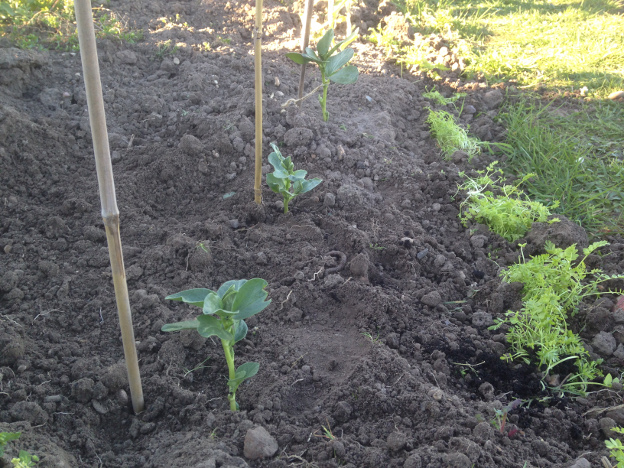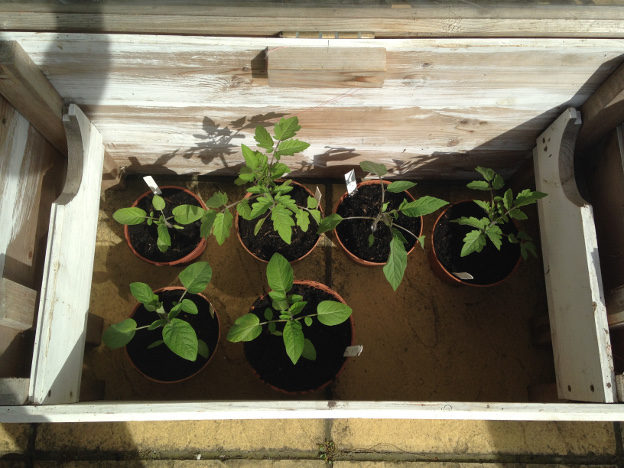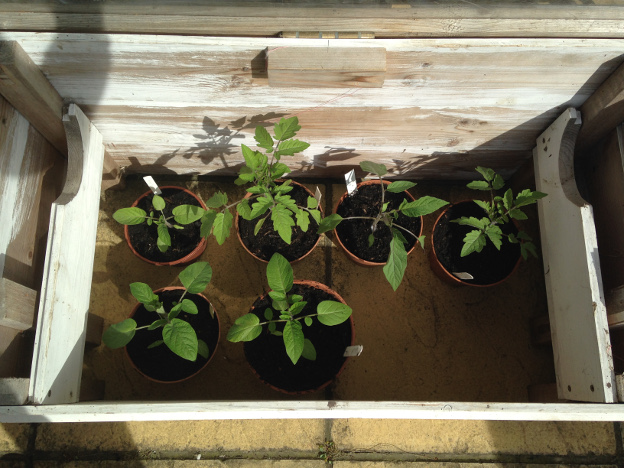‘March winds and April showers bring forth the May flowers’, or so the old proverb goes. Well if this March is anything to go by, then May should be a floral delight! The winds that Storm Doris brought in, and Storm Ewan perpetuated, have died down, but never seem to have fully left us.
But the days are now getting longer and spring is officially here. As of last weekend the clocks went forward which means it is still light when I get home from work. This week I have taken full advantage of this and I’ve been getting garden jobs done of an evening. However, by the time I’ve read our children their bedtime stories, I don’t get much time outside before we lose the daylight. But it won’t be long now before evenings can once again be a productive time in the garden and allotment.
We’re not the only ones enjoying the longer days. With the exception of our Court Pendu Plat apple tree, all of our fruit trees and bushes are no longer dormant, and most are becoming noticeably greener with every passing day. Our young rhubarb plants are growing enthusiastically and we have some rather well established tomato and chilli plants for the time of year.
When we took on the allotment the previous tenant had left a partially constructed homemade cold frame in the shed. A couple of weeks ago I brought this home and assembled it. Now the weather is that bit warmer I’ve moved some of our tomato plants out into it. We keep it on the patio in our front garden, which is south-facing. The tomato plants look very happy in it.
March has been a very busy month for us. Spring has finally started and we have a lot to do. For most of the month it has been quite dark by the time I got home, so evenings have been spent sowing and tending young plants indoors. But at the weekends we’ve been outside in the garden and at the allotment.
At the allotment we’ve been preparing the beds and also doing some sowing and harvesting. The most exciting job we have undertaken this month has been starting an asparagus bed. It’s something we’ve been thinking about for a while. As our available growing space grew with our acquisition of the allotment, we started to think more about growing low maintenance perennial crops. We also absolutely love to eat asparagus, so this crop was an obvious choice.
We decided that the allotment would be the best place for this project. There were two reasons for this. Firstly we only rent this house, and so we could spend a couple of years establishing this bed only to find we have to move house before we get to enjoy the fruits of our labour. Secondly our children play in the garden, and although they are generally good at playing away from our vegetables, an asparagus bed will be dormant for much of the year, and could easily be forgotten by the children when they are caught up in their games.
So we were settled on establishing our asparagus bed at the allotment. But whereabouts? We struggled to decide where to plant them. In theory wherever we chose would be out of action from a crop rotation perspective for a couple of decades. So the half of the allotment that has already given up growing space to a shed didn’t seem like the best option. But we decided that the shelter of the shed would be of benefit. Plus some of the space immediately next to the shed is already taken up by a water butt. So we’ve started our asparagus bed next to the shed and beside the water butt.
With regards to harvesting it’s mainly been leeks and carrots from the allotment. The yellow variety of carrot that we’ve grown has faired very well being left in the ground over winter. They haven’t gone at all woody, and still have a lovely flavour. Although we do have some nice thick leeks, most of them are not quite as thick as we would have liked. But they are still very useful to have.
We’ve also prepared the roots bed for this year. This was the part of the allotment in which we grew miscellaneous crops last year (mainly tomatoes and curcubits). We have also discovered that we can extend this bed. When we took on the plot there was a wide path of uncultivated land between our plot and the fence behind it. But apparently we don’t need to leave anything like as much of a path. So we’ve extended this bed an extra few feed back to give us more growing space.
So far we’ve planted some red and white onion sets into this bed. Both sets were given to us by people who had bought them and had leftovers. We have a lot of plans for this bed. As well as the onions we are planning to grow several varieties of carrots and potatoes, some salsify, root parsley and, a new one for us, some root chicory. In fact, I’ve still not got my head around what’s going where. We’ll also have a roots bed in our garden, but I’m still not convinced we’re going to have enough space to grow all of the above.
Last year’s brassica bed at the allotment has now finished. With only the tiniest shoots of purple sprouting broccoli in recent weeks, we decided it was time to lift the stems and turn the soil. We’ve worked some well rotted manure into this bed now, as this will be the miscellaneous bed this year, and squashes and pumpkins do like their manure.
Sticking with the allotment, we still have quite a few leeks in what was last year’s roots bed, as well as a few of the aforementioned carrots that we left in the ground. This bed is to be this year’s legumes bed. We’ve planted out a row of broad beans which we started in our back yard in pots. A couple of the plants have started to form flowers. In front of the beans we have planted some poached egg plants which were donated to us by my dad. These should act as good companion plants for our beans. They attract hoverflies which feed on aphids.

A row of broad bean plants (left) at our allotment, with a row of poached egg plants (right) to attract hoverflies.
In our garden we still have a few leeks and some purple sprouting broccoli. Our biggest project in the garden so far this calendar year has been preventing the hedgerow from creeping back into the big vegetable patch. The brambles have grown ferociously in recent weeks. The longer days always promise more productivity, but what they give with one had and take with the other, as the weeds also use the longer days to become more productive.
That concludes this month’s growing report. The coming month promises to be a productive one, with longer days and hopefully the end of the risk of frost. We still have a lot of crops to sow, potatoes to plant out and lots of growing decisions to make. The growing season has well and truly started, and we are very excited to be getting stuck in. Be sure to check back soon to see how we get on.
If you can’t wait a whole month to see what we’ve been up to, then follow us on Instagram, where we aim to post regular photos of our adventures in all things self-sufficiency.
https://www.instagram.com/slightlyselfsufficient/





